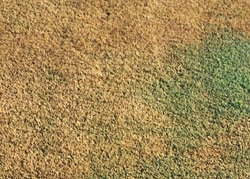Turf & Lawn Blog
Lawn Problems | Part 4 - Dry Patch
This is a simple name for a complex problem. Dry patch describes a condition where the soil in your lawn becomes water-repellent in patches (or hydrophobic), causing patches of brown, dead grass. No matter how much you water, or it rains, the ground in the patches remains absolutely dry. The causes are complex and not well understood, although one contributing factor is thought to be fungi coating the soil particles with water-repellent chemicals. Although not generally pathogenic and damaging to the plants themselves, they can nevertheless cause a major problem to the lawn as a whole.

How will you know if the cause of dead patches in your lawn is dry patch? The patches generally turn darker green first and then brown., but the real giveaway is that the symptoms develop in dry weather, but don’t improve when you water, or when it rains. And when you look at the affected area, you will find that the soil under the patch is absolutely dry. If you water it, the water will simply run off. You may even find that puddles form when it rains, but the soil remains bone-dry underneath. If you dig down in the roots, you may sometimes see fungal mycelium, or smell a fungal smell in the soil, but this is by no means always the case.
The best forms of control are good and regular maintenance of your lawn turf (see our turf range here). This includes scarifying (raking hard with a lawn rake or electric scarifier) in the autumn to improve aeration and remove thatch. Again in the autumn, you should improve drainage and help to prevent compaction by spiking the lawn with a garden fork or hollow-tine aerator. Regular feeding at the recommended intervals will promote strong healthy growth of grass with a good root system, which will make dry patch less likely.
If you do have dry patch, there are various ways to try to re-wet the soil, although it is very difficult. You can try spiking the area densely, and water it a little every day for a few days. There are ‘wetting agents’ available, which are chemicals that help the soil particles to absorb water. These are often used by professionals, but there are some available for domestic gardens. More than one treatment is likely to be necessary. Finally, if all your treatments, repeated over several months, are ineffective, you will need to remove the affected turf plus three or four inches of soil below, and replace it. You can buy good quality turf from turf suppliers to patch a reasonably small area, or fill in the soil with new topsoil and seed, if the area is quite small. Advice on patching a lawn can be found in our article on whether to seed or turf.
When you subscribe to the blog, we will send you an e-mail when there are new updates on the site so you wouldn't miss them.
